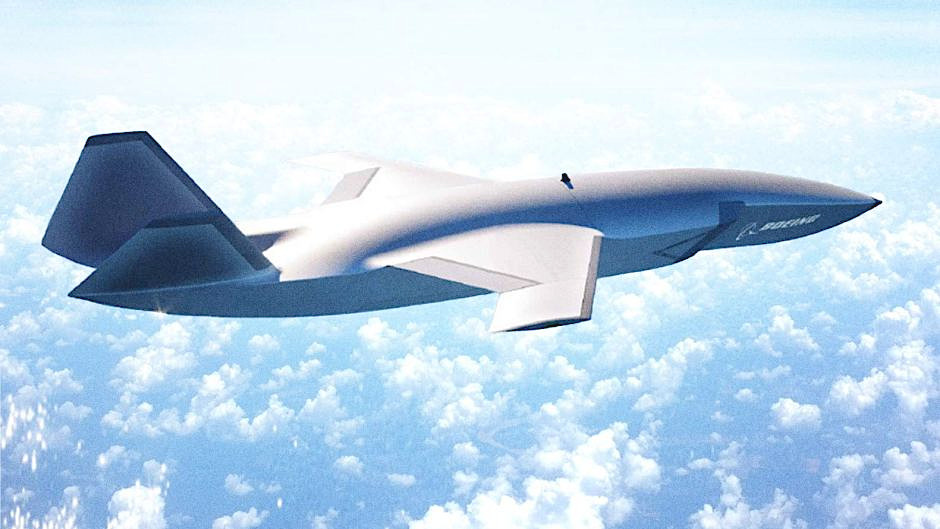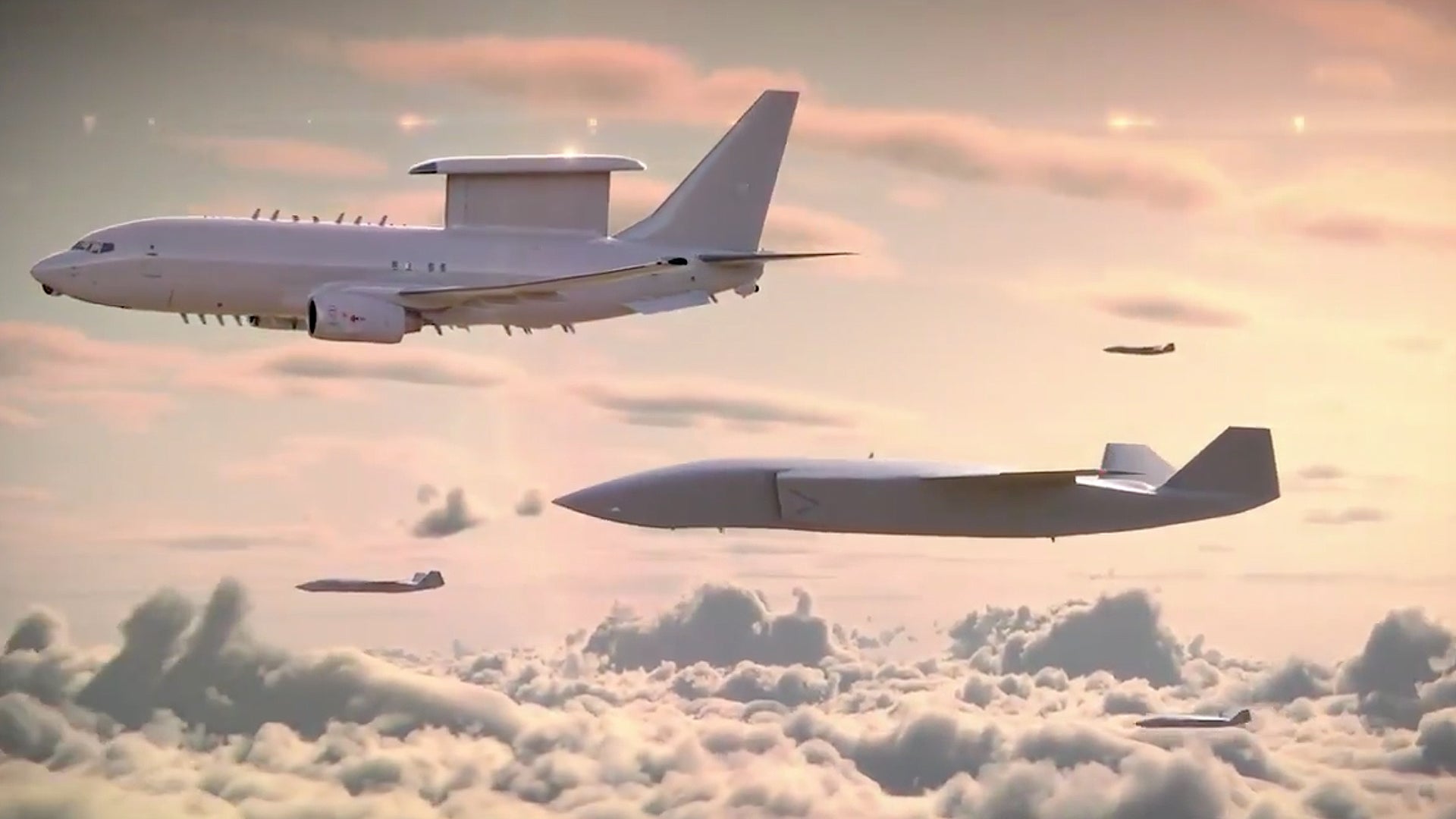As The War Zone
was first to report, Boeing is set to unveil a stealthy unmanned combat air vehicle, or UCAV, for the Royal Australian Air Force at this year’s Avalon Air Show in Australia. The pilotless plane appears to be a previously unseen clean sheet design and will be capable of operating as a “loyal wingman” with manned aircraft, such as Australia’s F-35 Joint Strike Fighters.
The Australian Broadcasting Company (ABC) was first to get the details of the new drone on Feb. 26, 2019. The day before, Boeing had teased the official reveal of the unmanned aircraft, which is still scheduled to come on Feb. 27, 2019.
The unmanned aircraft in the picture has a twin ‘taileron’ configuration similar to the YF-23 Black Widow, as well as wings centrally mounted on either side of the fuselage. The wings are similar to those found on General Atomics Predator-C/Avenger and more recently on a set of mysterious Scaled Composites test airframes. It also appears to have travazoidal air intakes on either side of the fuselage, likely feeding a single jet engine recessed at the rear to minimize infrared signature. The drone’s planform is distinct from the company’s MQ-25 Stingray drone tanker for the U.S. Navy and appears to be completely unrelated to the earlier Phantom Ray flying wing design.
Beyond the picture, seen at the top of this story and below, ABC obtained few additional details as to the drone’s capabilities. The report suggested that the UCAV could be close to 40 feet long and feature a modular payload bay capable of accepting sensors, electronic warfare systems, and ordnance.

Boeing has reportedly been developing the unmanned aircraft locally in Brisbane, Australia, as a part of a classified “Loyal Wingman” program for the Royal Australian Air Force (RAAF) and Australia’s Department of Defense (DOD). Australia’s Defense Minister Christopher Pyne will be the one to formally unveil the drone tomorrow, according to ABC.
Deputy chief of the RAAF Air Vice-Marshal Gavin Turnbull alluded to this project in an interview that the Australian Strategic Policy Institute think tank published on Feb. 27, 2019. The service is otherwise in the midst of a major modernization effort known as Plan Jericho, which is focused in part in working to exploiting artificial intelligence, machine learning, and manned-unmanned teaming to make up for its relatively small overall force structure.
“In terms of bang for buck, it’s how we can have the biggest effect in making our people successful in any combat environment that they may have to enter,” Turnbull explained. “We have to be able to provide a level of deterrence that means, if you snap at us and we have to bite, it’s going to hurt.”
“So into the future you have to give consideration to what the force mix looks like between manned and unmanned combat entities,” he continued. “And there will always be a synergy in mixing them in some way.”
The War Zone’s Tyler Rogoway touched on exactly these potential benefits of Australia acquiring a UCAV capability in yesterday’s article, writing:
An unmanned combat air vehicle that is capable of some semi-autonomous missions and can operate in the loyal wingman role, where it is ‘tethered’ to and takes directions from a nearby manned platform via data-link, makes a lot of sense for Australia as it would boost their air combat capabilities without needing to buy additional high-cost fighters or train new aircrews. It also would also make all their fighter force more survivable and capable of adapting to hostile threats on the fly. In addition, it would also increase their fighter cadre’s magazine capacity, sensor diversity, range. The drones themselves can also be networked together in a swarm, giving them greater capability than the sum of their parts.
These concepts can be manifested in distinct aircraft, or potentially blended together in a single airframe, albeit with some compromises. But still, they should be less expensive than a very stealthy, high-end, flying-wing UCAV that is built for semi-autonomous or even autonomous operations deep in enemy territory.
A full-on fighter-like UCAV is also possible, but due to cost and the investment Australia has already made in their growing fleet of F-35s, this seems doubtful at this time. Also, high kinetic performance would mean sacrificing stealth and range, something that makes little sense really. And we know by the features Boeing has shown that this aircraft is designed for fighter-like speed and maneuverability, not extreme stealthiness and long range.
Boeing was the first to openly prove the incredible potential of unmanned combat air vehicles (UCAVs) nearly two decades ago, but has since struggled to bring their vision into an operational state. With this in mind, tomorrow’s announcement will be a huge coup for the Chicago-based planemaker and is only likely to open up new opportunities. In addition, considering Boeing also won the Navy’s MQ-25 contract, the company is now sitting firmly on the leading edge of advanced unmanned aircraft development.
We will continue to update this story as more information becomes available.
UPDATE: 3:25pm PST—
Looks like someone got a peak in the Boeing tent at Avalon. There is what appears to be a mockup. A prototype is possible due to the poor quality of the image, but it’s doubtful. Still, it gives us a sense of scale.
Now Boeing just posted this video showing CGI of the aircraft in actions in manned-machine teaming mode alongside an Aussie Growler and an E-7 Wedgetail. Oh, and its name is officially the Boeing Airpower Teaming System:
A clearer image of the mockup:
UPDATE: 3:47pm PST—
Some basic facts about the Air Airpower Teaming System:
- It is built in Australia and intended for export around the globe. Exports will be easier without having to go through U.S. FMS process.
- A prototype is being built now.
- Can fly with or without a manned partner.
- Has a range of roughly 2,000 miles.
- Is 38 feet long and uses a bizjet class engine.
- Will team with E-7, EA-18G, F/A-18E/F, and P-8 Poseidon.
- Modular design for ‘snap-in’ payloads and rapid reconfiguration capability.
- Initial configuration will be sensor/intelligence and electronic warfare focused.
- Controlled via ground station, other aircraft, and has some level of autonomy that can scale for the mission.
- Design was based mainly on what would be attractive to a global market full of cash-strapped air arms.
- Will be tested over Australia’s vast deserts where there is tons of room for experimentation. (Probably based out of Woomera)
- The technology and development will be sourced locally in Australia.
- Boeing will be able to adapt the technology for foreign customers far easier than developing and building in the United States.
You can read more here at Aviation Week’s embargoed exclusive. I will be doing a big picture analysis soon that addresses issues not discussed in that report.
Editor’s Note: Boeing informed us that a dollar figure for money spent on the program by Boeing in Australia (AU$62M) was not accurate, so we removed it from our post. The figure came from the Aviation Week exclusive linked above.
Contact the author: Tyler@thedrive.com
